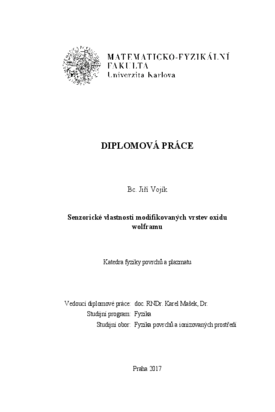Senzorické vlastnosti modifikovaných vrstev oxidu wolframu
Gas sensing properties of tungsten oxide thin films
diploma thesis (DEFENDED)

View/
Permanent link
http://hdl.handle.net/20.500.11956/85690Identifiers
Study Information System: 165804
Collections
- Kvalifikační práce [11587]
Author
Advisor
Referee
Haviar, Stanislav
Faculty / Institute
Faculty of Mathematics and Physics
Discipline
Physics of Surfaces and Ionized Media
Department
Department of Surface and Plasma Science
Date of defense
8. 6. 2017
Publisher
Univerzita Karlova, Matematicko-fyzikální fakultaLanguage
Czech
Grade
Excellent
Keywords (Czech)
konduktometrický senzor, vodík, oxid wolframu, XPSKeywords (English)
conductometric sensor, hydrogen, tungsten oxide, XPSPředmětem předložené práce je studium senzorických vlastností čistých, platinou dopovaných a zlatem dopovaných tenkých vrstev oxidu wolframu. Požadované vrstvy byly připraveny magnetronovým naprašováním na sklo a oxidovaný křemík. Jejich chemické složení bylo studováno metodou XPS. Jejich morfologie byla měřena pomocí AFM a SEM. Senzorická odezva vrstev v intervalu 1 000 až 10 000 ppm vodíku byla studována při teplotách od 100 do 350 řC. Ukázalo se, že během senzorických testů docházelo k částečné redukci oxidů platiny PtO2 a PtO až na kovovou platinu a jejímu zapouzdření oxidem wolframovým. Citlivost dopovaných vrstev byla zvláště na nižší koncentrace vodíku mnohem vyšší než v případě čistých vrstev. V případě platinou dopovaných vrstev citlivost klesala s rostoucí teplotou na rozdíl od zlatem dopovaných vrstev, kde citlivost naopak s teplotou rostla. Zlato se po přípravě nacházelo ve dvou stavech - v kovovém a ve formě oxidu Au2O3. Během senzorických testů došlo k jeho redukci. Senzorické testy způsobily zvětšení krystalických zrn a v případě platinou dopovaných vrstev také výrazné zvýšení jejich hrubosti.
The purpose of this thesis is a study of sensing properties of pure, platinum-doped and gold-doped tungsten oxide thin films. Required films were prepared by magnetron sputtering on glass and passivated silicon. Their chemical composition was investigated by XPS. The morphology of the films was measured using AFM and SEM. Sensing response of these films to hydrogen was investigated in the range from 1,000 to 10,000 ppm and temperatures between 100 and 350 řC. It was found that platinum oxides PtO2 and PtO were partially reduced during the sensing tests. The possible encapsulation of the platinum by the tungsten oxide was discovered. The sensitivity of the metal doped films was much higher than the sensitivity of the pure films. In the case of platinum-doped films the sensitivity decreased with increasing temperature in contrast to the gold-doped films where the sensitivity increased. The gold was present in two metallic and oxidized states. The gold was reduced during the reactions with hydrogen. After the sensing tests, the size of crystalline grains increased and the platinum-doped films became coarser.
